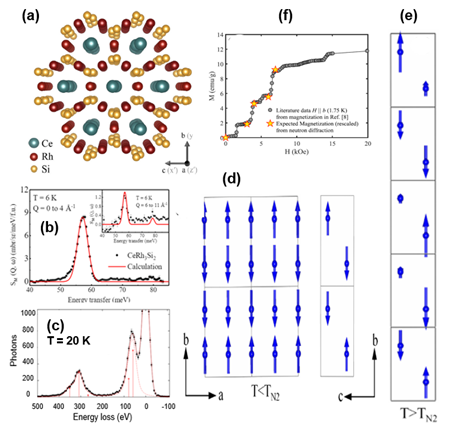CeRh3Si2 is a compound that has a number of interesting features, including anisotropic magnetism and a very large crystal-field splitting. It also shows unusual metamagnetic behaviour upon cooldown: a first phase transition that changes it from being paramagnetic to antiferromagnetic and a second phase transition that changes the magnetic structure. This occurs just below 5 K. Its magnetism can also be controlled using a magnetic field.
To understand this complex magnetic behaviour, an international group of researchers has used a combination of neutron and x-ray techniques. In their study, published in Physical Review B, they used inelastic neutron scattering (INS) on the Merlin instrument at ISIS, resonant inelastic x-ray scattering (RIXS) on the ID32 beamline at the ESRF and neutron diffraction on the WISH beamline at ISIS.
Their INS and RIXS experiments enabled them to directly study the giant crystal-field splitting, fully characterising the behaviour of the Ce3+ ions in a way that was only possible by combining both inelastic neutron and x-ray scattering studies.
They used neutron diffraction to study the material in zero-field and were able to explain two magnetic phase transitions through different magnetic structures. In addition, by doing neutron diffraction experiments in different applied magnetic fields, they were able to identify and characterise the multiple magnetic structures formed by the material.
By combining the use of neutron and x-ray scattering, the team were able to get a full understanding of the magnetic anisotropy, the two magnetic phase transitions and the metamagnetic transitions observed when a magnetic field is applied.

Figure (a) Pseudohexagonal crystal structure of CeRh3Si2 viewed from the orthorhombic c-axis, (b) Inelastic neutron excitations, (c) Resonance inelastic (RIXS) excitations, (d-e) Zero-field magnetic structure at 2 K and 4.5 K and (f) Magnetization isotherm, magnetization steps explained from neutron diffraction.
Further information
The full paper can be found online at DOI: 10.1103/PhysRevB.105.125119
